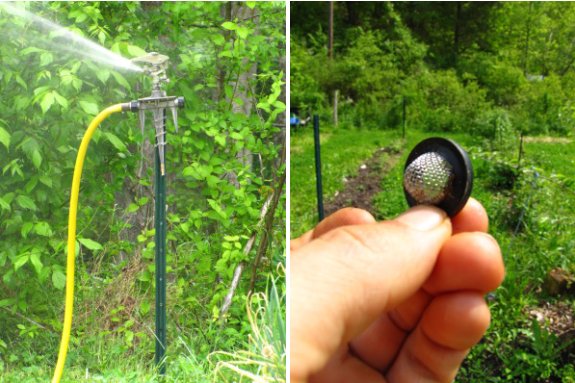
Sprinkler modification needed for creek pumping

The
pump in our creek sucks
up tiny particles that eventually clog up the stainless steel filter on
our reciprocating lawn sprinklers.
We started experimenting with
deleting the filters last year. The initial concern was that the
sprinkler head might get gunked up and stop working. That hasn't
happened yet, even with the junkier plastic version.
I have a feeling this
modification wouldn't work on a system with lower pressure, but it
might be worth a try. The replacement cost for these things is less
than 10 dollars, but the feeling of security one gets knowing you can
water the garden during a dry spell is priceless.
Want more in-depth information? Browse through our books.
Or explore more posts by date or by subject.
About us: Anna Hess and Mark Hamilton spent over a decade living self-sufficiently in the mountains of Virginia before moving north to start over from scratch in the foothills of Ohio. They've experimented with permaculture, no-till gardening, trailersteading, home-based microbusinesses and much more, writing about their adventures in both blogs and books.
Want to be notified when new comments are posted on this page? Click on the RSS button after you add a comment to subscribe to the comment feed, or simply check the box beside "email replies to me" while writing your comment.

Next time you need to buy a hose, look for hose resistant to alae and other microbial growth. They don't cost more than others and do tend to last longer than plane old hoses. I have had some hoses like this in use for several years now, left pressurized all the time and have had no problems with plugging manual nozzles with any sort of debris, living or inert. I do remember having this problem years ago but not since using hosing more resitant to this problem. These hoses also tend to last longer when left pressurized continuously as I leave them.
I also pick nits about over torquing water hose fittings which causes premature failure of the hose washers. If it has to be more than hand tight then the washer needs replaced. If it is new and is more than hand tight it is likely to leak soon and making it too tight will often damage the hose male and/or female fitting threads.
The next nit I pick is the one about people forcing the male hose fitting onto 3/4" pipe threads. 3/4" pipe thread is a nominal size having nothing to do with it's actual dimensions, with 14 threads per inch and the thread is tapered. While water hose fittings are straight thread with 12 threads per inch. As the water hose fittings are normally brass or plastic, they can be forced onto pie thread but in the process are ruined and when divorced from each other the hose fitting is generally useless. The problem is preventable with inexpensive adapters available at most hardware stores and any catalog like Grainger's.
Well the nits are picked and I hope the comments prevent someone having trouble with water hoses.
That's excellent information! I didn't realize that they made algae-resistant hoses. I'll have to look into that when our current hoses finally die.
Luckily, your second point isn't relevant to us --- we always hand tighten. But your third point makes me wonder if we got the right fittings to go from the PVC pipes to the hoses. I'll have to check on that.